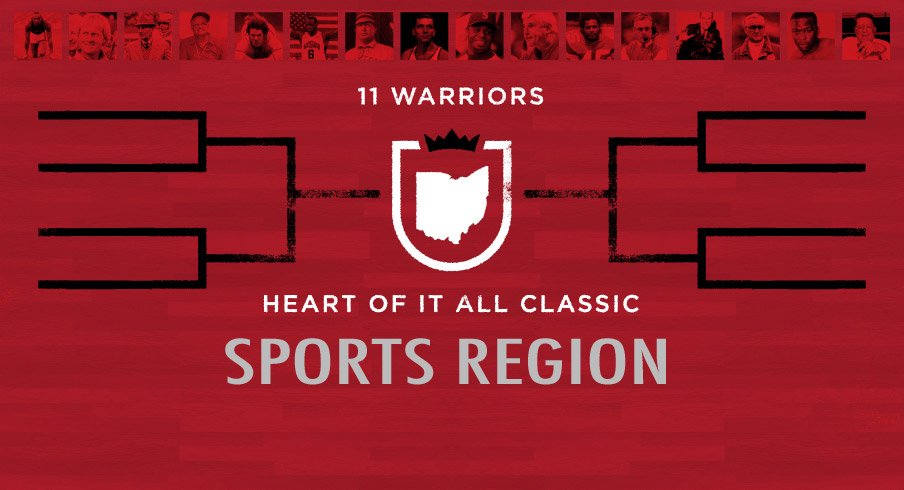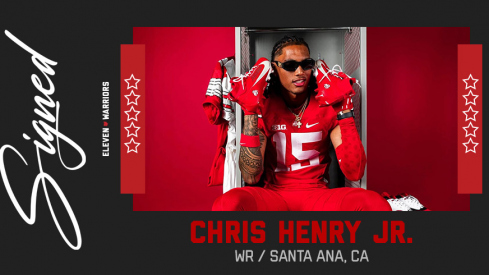Day two of The 11W Heart of It All Classic is upon us and we're now tasked with selecting the survivors of the first round of the Sports region. This region is stacked, but potential upsets loom.
If you need a refresher, you can read up on the full rules and seedings. Here's your printable bracket (PDF).
Winners of first round games in the Sports region will be announced Saturday night with the second round of voting opening up Sunday morning.
#1 Jesse Owens vs. #16 Branch Rickey
Jesse Owens: At the age of nine, Jesse Owens' family escaped the institutional racism of the South – Oakville, Alabama in this case – and moved to Cleveland. While attending East Technical High, Owens tied the world records for the 100-yard dash (9.4) and long jump (24 feet 9½ inches) at the 1933 National High School Championship.
Later, at Ohio State, Owens won a record eight individual NCAA championships – four each in 1935 and '36 – but he's most remembered for a 45-minute span during the 1935 Big Ten Championship at Ferry Field in Ann Arbor, Michigan, where he set three world records and equaled his 9.4-second 100 again. He was so dominant that Michigan – the University of Michigan – built a monument for him.
Having smoked everyone in the United States, the "Buckeye Bullet" went to Berlin for the 1936 Summer Olympics and promptly won four gold medals, putting a crimp in Hitler's notion of a master race.
Branch Rickey: Wesley Branch Rickey was born in tiny Stockdale, in Pike County, Ohio and attended Ohio Wesleyan University, where he played baseball and dabbled in semi-pro football.
In 1913, Rickey was hired by the St. Louis Browns for a role in the team's front office. After taking time to serve as an officer in the U.S. Army during World War I (where he commanded the likes of Ty Cobb and Christy Mathewson), he returned to baseball, accepting a job as the president and manager of the St. Louis Cardinal.
As a manager and executive, his team would win the World Series four times, but he's most known for his role helping to break baseball's color barrier when he signed Jackie Robinson to the Brooklyn Dodgers in 1945.
#2 Jack Nicklaus vs. #15 Buster Douglas
Jack Nicklaus: "The Golden Bear" won the first of five straight Ohio State Junior titles at the age of 12. And then, for the next four decades of his life, he kept winning and winning.
While at Ohio State, Nicklaus won the U.S. Amateur twice (1959 and '61) and the NCAA Championship in 1961. As a junior, he finished second to Arnold Palmer at the U.S. Open, recording a 65 on the final round – still an amateur U.S. Open record to this day.
He notched his first professional win in his 17th start, defeating Palmer at the 1962 U.S. Open. The following year, Nicklaus won two more majors, The Masters and the PGA Championship. He'd collect 15 more majors before retiring, including the 1986 Masters at the age of 46. His 18 majors and six wins at Augusta are both records.
Buster Douglas: James "Buster" Douglas was born in 1960 to the son of professional boxer William "Dynamite" Douglas in Columbus. While attending Linden McKinley High School, Douglas starred in football and basketball but returned to boxing following a short stint playing community college basketball.
During the first eight years of his career as a professional boxer, Douglas ran up an impressive 29-4-1 record, but was knocked out by Tony Tucker in his only title fight. In February of 1990, he earned a shot against heavyweight champion Mike Tyson, then 37-0 and considered the baddest dude on the planet. Douglas would enter the bout as a 42-1 underdog.
Fighting just 28 days after his mother had passed, Douglas put on a clinic, battering the invincible Tyson before eventually knocking the champ out in the 9th round. The fight shocked the boxing world and is still considered the biggest upset in the history of the sport.
#3 Paul Brown vs. #14 Don Shula
Paul Brown: Some men are put on earth to win football games. Paul Brown was one of those men.
Born in Norwalk, Brown built a juggernaut at Massillon Washington High School before getting the call to take over at Ohio State. He spent three seasons in Columbus, winning the school's first national championship in 1942.
In 1945, Brown accepted the head coaching position for the new Cleveland team in the All-America Football Conference. The team took his name and promptly won four league titles. He would coach the Browns to three NFL championships after the merger before helping to found another franchise, the Cincinnati Bengals.
There are two major stadiums named for Brown in the state of Ohio and his coaching tree is more of a coaching forest.
Don Shula: Born in Grand River, on the shores of Lake Erie, in 1930, Don Shula starred as a halfback for Painesville's Harvey High School. He played his college ball at John Carroll University in Cleveland and was picked in the 9th round of the 1951 NFL draft by – wait for it – Paul Brown and his Cleveland Browns.
After a seven-year career in the NFL, Shula got his first coaching job as an assistant at the University of Virginia. The following season, he jumped to the University of Kentucky, and then, a year later, to the Detroit Lions in 1960. In 1963, at the age of 33, he was named the head coach of the Baltimore Colts, where he went 71-23, but lost Super Bowl III to Joe Namath and the New York Jets.
In 1969, he took his talents to South Beach, appearing in three Super Bowls – and winning two of them – in his first four seasons as the head coach of the Miami Dolphins. He spent 26 seasons in Miami and finished his career with 347 wins, an NFL record.
#4 Woody Hayes vs. #13 Roger Staubach
Woody Hayes: Born in Clifton, Ohio, and reared in Newcomerstown, Woody Hayes became the face of Ohio State football, despite his ignominious exit from the college game.
Following a stint as the commander of PC 1251, a submarine chaser, in World War II, Hayes returned to Denison University, his alma mater, where he coached for three years before moving on to Miami University. In 1950, his Redskin team went 9-1, defeating Arizona State in the Salad Bowl.
Hayes accepted the Ohio State job in 1951 and went 205-61-10 in his 29 seasons with the school, winning national championships in 1954, 1957, 1961, 1968 and 1970. He was inducted into the College Football Hall of Fame in 1983, is honored by the school with a statue outside the Woody Hayes Athletic Center and to this day, inspires Ohio State fans to pay it forward.
Roger Staubach: Before Roger Staubach found Drew Pearson for a last-second, 50-yard bomb to win a 1975 playoff game for the Cowboys, that type of play, arguably the most exciting in the game, did not have a name. Following that 17-14 victory over the Vikings it did: the "Hail Mary."
Staubach, born in Cincinnati, starred at the U.S. Naval Academy, winning the Heisman Trophy in 1963. He then served as a Supply Corps officer for the Navy in Vietnam before entering the NFL as a 27-year-old rookie in 1969.
"Rodger the Dodger" spent his entire 11-year NFL career with the Cowboys, winning two Super Bowls, earning six Pro Bowl selections and entering the Pro Football Hall of Fame in 1986.
#5 Pete Rose vs. #12 Jim Tressel
Pete Rose: Rose would have an argument for a top-three seed, had he not bet on his team, earning a lifetime ban from baseball.
For his achievements in the park, he'll be remembered as one of the best baseball players to ever play the game. The Cincinnati native is Major League Baseball's hit king, finishing with 4,256 hits during his 24-year career (only four other players have more than 3,500). He owns MLB records for career singles (3,215), games played (3,562) and seasons of 200 or more hits (10), in addition to National League records for runs (2,165), doubles (746) and five-hit games (10), among many others.
Still, it's the 1989 Dowd Report, which concluded Rose had bet on baseball, including his own team, which forever haunts his legacy.
Jim Tressel: James Patrick Tressel was born in Mentor, Ohio, to the son of a football coach. Following graduation from Berea High School, Tressel played quarterback for his father, Lee, at Baldwin-Wallace, and then embarked upon his own coaching career, which would be impressive.
In 1975, Tressel accepted a graduate position at Akron. He coached three seasons each at Miami and Syracuse before finding his way to Ohio State, where he coached quarterbacks under Earle Bruce from 1983-85. He then became the head coach at Youngstown State and proceeded to roll teams in FCS, then known as Division I-AA. In 15 years at YSU, he won 135 games and four national titles.
Following John Cooper's exit in 2001, Tressel took over at Ohio State, winning 106 games in 10 seasons, including the school's first national championship in 34 years. He was particularly effective against Michigan, going 9-1 against the Wolverines. Despite his "resignation" for covering up NCAA violations, he rivals Woody Hayes for the affection of Buckeye fans.
#6 LeBron James vs. #11 Archie Griffin
LeBron James: Perhaps the most physically gifted athlete to come out of Ohio, LeBron James was born in Akron in 1984 and attracted attention on the basketball court not long after.
As a freshman at St. Vincent–St. Mary High School in Akron, James led his team to a 27-0 record and the Division III state title. By his junior season, he had appeared on the cover of Sports Illustrated (the first prep underclassmen to do so) with the header "THE CHOSEN ONE" and then killed any jinx by becoming the first junior to win the boy's basketball Gatorade National Player of the Year Award.
By the time he was eligible for the NBA Draft in 2003, he had become the most hyped prep basketball player ever. Cleveland took him with the No 1 overall pick and James confirmed the hype in his first game by dropping 25 on Sacramento. In his 11 years in the league, he has two NBA championships and four league MVP awards.
Archie Griffin: The only two-time winner of the Heisman Trophy, Archie Griffin was born and grew up in Columbus, starring for Eastmoor High School.
In 1972, the first year the NCAA permitted freshmen to play varsity football, Griffin arrived at Ohio State and cracked the lineup early, rushing for 867 yards that year. As a sophomore, Griffin ran for 1,577 yards, topping it with 1,695 yards as a senior, before finishing his Ohio State career with another 1,450 yards as a senior. His 5,589 rushing yards set an NCAA record and he became one of only two players to start in four Rose Bowl games.
As many Ohio State fans have come to realize, Griffin was quite the man off the field, too. His coach, Woody Hayes, once remarked, "He's a better young man than he is a football player, and he's the best football player I've ever seen."
#7 Cy Young vs. #10 Bobby Knight
Cy Young: When pro baseball names one of its most prestigious awards for you, it's safe to say you had one hell of a career. Cy Young, from one-church Gilmore, Ohio, had all of that and more.
In 21 seasons as a Major League pitcher, Young threw longer, harder and better than anyone then or since. He holds MLB records for wins (511, or 94 more than No. 2 on the list, Walter Johnson), complete games (749), starts (815) and consecutive hitless innings pitched (25⅓) among many others.
Young tossed three no-hitters, the first perfect game in baseball's "modern era," was a second-ballot Hall of Famer and was named to Major League Baseball's All-Century Team.
Bobby Knight: "The General" was born in Massillon (the same year Paul Brown was winning his final prep national title just down the street) and grew up in Orville, near Akron.
In 1958, he arrived at Ohio State to play under Fred Taylor. While there, he was part of a team that won the 1959 NCAA Championship and finished second the next two seasons 1960 NCAA Championship. Following graduation, Knight entered into coaching, first at Cuyahoga Falls High School and then for six years at West Point.
In 1971, Indiana chose Knight to lead the Hoosiers and Knight quickly found success, reaching the Final Four in his second season in Bloomington. In his 29 seasons at IU, Knight won 662 games, including NCAA Championships in 1976, 1981 and 1987. His 1975-76 team is the last team to have capped an undefeated season (36-0) with a title and his 902 career wins set an NCAA record that was eventually eclipsed by one of his protégés, Mike Krzyzewski.
#8 Jerry Lucas vs. #9 Ken Griffey Jr.
Jerry Lucas: The pride of Middletown (with all due respect to Cris Carter), Jerry Lucas dominated the game of basketball at every stage of his career.
As a 15-year-old sophomore, Lucas led the Middies to an undefeated season and a state championship, going off for 53 points in the state semifinals, and then 44 more in the finals. He would lead his team to a then national prep record of 76 straight wins, collecting two national player of the year awards on the way to breaking Wilt Chamberlain's high school scoring record.
With John Havlicek, Lucas led Ohio State to a national title when both were sophomores. Although the Buckeyes would lose the next two national championship games to Cincinnati, Lucas was named national player of the year his final two seasons.
As a pro, Lucas won one NBA championship, was named an all-star seven times, to the NBA's 50th Anniversary All-Time Team, and the Basketball Hall of Fame.
Ken Griffey Jr.: The son of a Cincinnati Reds great, Ken Griffey Jr. attended Archbishop Moeller High School in Cincinnati, where he was named the nation's high school baseball player of the year in 1987.
Later that year, he was selected No. 1 overall by the Seattle Mariners and recorded a double in his first MLB at-bat two years later. A true five-tool player, Griffey led the AL in home runs four times, while winning Gold Gloves for 10 straight seasons from 1990-99.
The 1997 AL MVP was a 13-time all-star, made the MLB All-Century Team and is enshrined in the Seattle Mariners Hall of Fame. In 2016, he'll be eligible for the Major League Baseball Hall of Fame.


